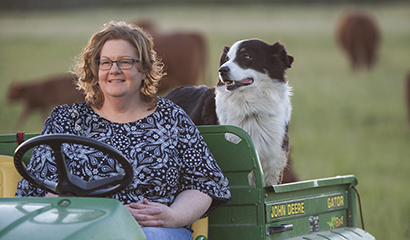
New centre to create lasting legacy
For Janice Bruynooghe, the Livestock and Forage Centre of Excellence (LFCE) isn't just about research. It's about creating a network between all facets of livestock industry and research.
By HenryTye GlazebrookThe goal, she says, is a level of interconnectivity that not only best reflects those relationships that already exist but also promotes a strengthening of those bonds.
“Our challenge in industry is not just dealing with a crop like a bale of hay or an acre of grass. Forage is an input to the livestock sector, so that connection between plant and animal and even soil is very complex when we talk about research and management,” she says.
“Rather than cutting the pie into little pieces and just focusing on one aspect, we’re going to come at it from a broader approach. That’s why I think particularly for our combined industry, the approach of the centre is going to work — and the return is going to be huge.”
The LFCE is a project aimed at uniting all aspects of livestock and forage production under a single umbrella. Bruynooghe, who is a partner in Spring Creek Land and Cattle Consulting, is a professional agrologist and has a background in livestock and forage production. She has been helping to oversee the LFCE’s development as a member of the project’s steering committee.
Bruynooghe believes the LFCE has the potential to elevate the U of S and Saskatchewan as a whole to a new tier in the research and production of livestock and forage.
“It’s huge. It’s important to recognize that Saskatchewan is seen as a leader when it comes to livestock and forage. But we have an incredible opportunity through the LFCE to expand that even further — both into Western Canada and nationally, but also internationally,” she says.
“We’ve got the pieces right now, but by adding to it, we’re creating a hub of expertise here.”
The first step of that process is creating a more effective connection between research and industry partners, allowing for a clearer exchange of information and a smoother study and implementation process.
“I think that the integration the centre of excellence provides is going to give us the opportunity for industry and researchers to be more closely linked,” she says. “We’re going to improve the interaction, which is going to lead to a better understanding on both sides in terms of what stakeholders’ priorities are when it comes to research.”
The LFCE is especially exciting for Bruynooghe in its ability to create a meaningful step forward in research, which she believes will create a stream of innovation that flows outward into other areas.
“Ranchers and producers — they’re looking for new management options, they’re looking for new technologies. We need to increase capacity, and that’s what we’re going to get,” says Bruynooghe, whose family raises beef cattle and forage near Outlook, Sask.
“It’s going to mean enhanced and expanded research, which leads to added outputs and … increased and sustainable productivity. The future will look bright for the next generation of producers.”
For Bruynooghe, a graduate of the U of S, the centre’s lasting legacy will be found in the students that use its tools to learn and develop into agricultural leaders.
“If we look at potential students, the resources we’re going to be able to provide them and improve upon are huge. Our university is already seen as top notch when it comes to agriculture and agriculture research, but this centre will be a real flagship in Canada.”
Although the LFCE is most immediately aimed at research and industry benefits, Bruynooghe says its improvement of these services is one that will help consumers as well.
“The centre is not just for the benefit of producers, researchers and the university. It’s for society as a whole. We’re in the business of producing food.”
Article re-posted on .
View original article.

